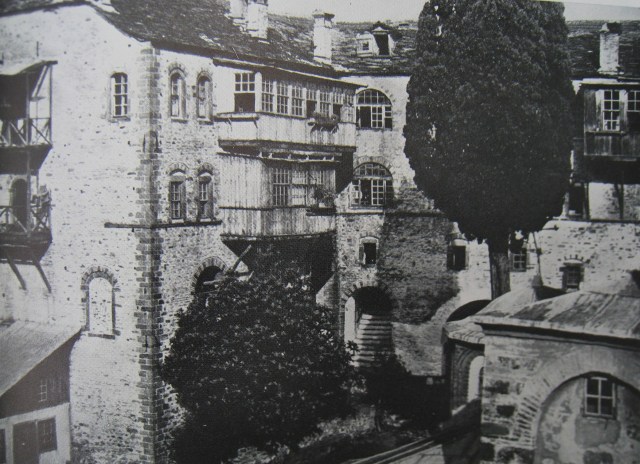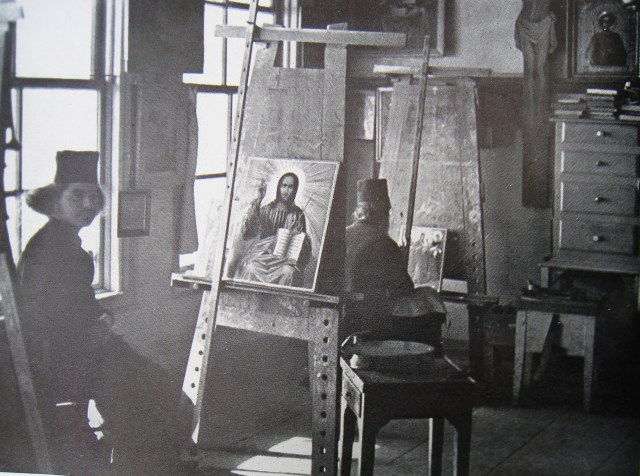In post 1309 I showed you the text from the article, here are the pictures, all made by mr. Brewster himself, exept for the photo of the interior of the Lavra refectory from David Talbot Rice and one of the exterior by A. Costa.
 “Arriving at Daphni, the port of Athos and its only gateway to the outside world”
“Arriving at Daphni, the port of Athos and its only gateway to the outside world”
 “Each monastery is represented in the Holy Synod in Karyes, the capital – a miniature town with shops and tiny restaurants along its vine-hung street, where no woman or child may tread”
“Each monastery is represented in the Holy Synod in Karyes, the capital – a miniature town with shops and tiny restaurants along its vine-hung street, where no woman or child may tread”
 “Just outside Karyes is a ‘hierarchical college’ for novices on the Holy Mountain” – the Athonasias school in the Skiti Andreou/Serail – also see picture on the front page.
“Just outside Karyes is a ‘hierarchical college’ for novices on the Holy Mountain” – the Athonasias school in the Skiti Andreou/Serail – also see picture on the front page.
 “Set amid flourishing gardens, with church, chaples, towers, dwelling- and store-houses grouped about a courtyard, Esphigmenou displays the principal features of the larger monasteries”.
“Set amid flourishing gardens, with church, chaples, towers, dwelling- and store-houses grouped about a courtyard, Esphigmenou displays the principal features of the larger monasteries”.
 “Besides 5000 monks, over 2000 peasants and lay brothers work on Athos. A joint picnic at the Lavra”.
“Besides 5000 monks, over 2000 peasants and lay brothers work on Athos. A joint picnic at the Lavra”.
 “Simonopetra – most spectacular of the monasteries – with wooden galleries instead of corridors from room to room”.
“Simonopetra – most spectacular of the monasteries – with wooden galleries instead of corridors from room to room”.
 “The eastern side of the peninsula is fertile, sloping gently to the sea. The arsenal of Iveron (above) was used to shelter the monks’ boats when pirates roamed the Aegean. The western side is steep and rugged: Gregoriou (below), like Simonopetra, is built on rocks over the water”.
“The eastern side of the peninsula is fertile, sloping gently to the sea. The arsenal of Iveron (above) was used to shelter the monks’ boats when pirates roamed the Aegean. The western side is steep and rugged: Gregoriou (below), like Simonopetra, is built on rocks over the water”.
 “The southern end, too, is wild and rocky, where hermits dwell in caves an where, amoung the foorhills of Mount Athos itself, stands the monastery of St. Paul’s (above). The north is richly wooded: deep in the forest lies the ancient Serbian monastery of Chilandari”.
“The southern end, too, is wild and rocky, where hermits dwell in caves an where, amoung the foorhills of Mount Athos itself, stands the monastery of St. Paul’s (above). The north is richly wooded: deep in the forest lies the ancient Serbian monastery of Chilandari”.
 “Many monks come to the Holy Mountain at an early age, like this novice of Vatopedi”.
“Many monks come to the Holy Mountain at an early age, like this novice of Vatopedi”.
 “Athos was long under the domination of the Turks, who forbade the use of the bell: services are still announced with the semonatron, a gong of hardened wood, beaten with a mallet”.
“Athos was long under the domination of the Turks, who forbade the use of the bell: services are still announced with the semonatron, a gong of hardened wood, beaten with a mallet”.
 “Russian monks leaving church. All eldery men, they are no longer joined by newcomers from Russia”.
“Russian monks leaving church. All eldery men, they are no longer joined by newcomers from Russia”.
 “Athos is a world of its own, where Greeks, Russians, Serbians and Bulgarians, anchorites and men of affairs, saintly men and ex-criminlas share a common isolation”. – Brewster forgets to mention the Rumenians!
“Athos is a world of its own, where Greeks, Russians, Serbians and Bulgarians, anchorites and men of affairs, saintly men and ex-criminlas share a common isolation”. – Brewster forgets to mention the Rumenians!
 “The gaily painted courtyard of the great monastery of Vatopedi, known as the Paris of Athos, where there is electric light and modern sanatation and where the monks go about in silken robes”.
“The gaily painted courtyard of the great monastery of Vatopedi, known as the Paris of Athos, where there is electric light and modern sanatation and where the monks go about in silken robes”.
 “Philotheou, much – but tastefully – rebuilt, recruits its members largely from Greeks outside Greece”.
“Philotheou, much – but tastefully – rebuilt, recruits its members largely from Greeks outside Greece”.
 “The interior walls of both churches and refectories are covered, from floor to ceiling, with paintings. Those in the refectory at the Lavra date from 1512, its marble-topped tables from about A.D. 1000”.
“The interior walls of both churches and refectories are covered, from floor to ceiling, with paintings. Those in the refectory at the Lavra date from 1512, its marble-topped tables from about A.D. 1000”.
 “The guesthouse cook and his assistant at the Lavra” – a famous Athos picture ….
“The guesthouse cook and his assistant at the Lavra” – a famous Athos picture ….
 “The rocky southern end of the peninsula is dotted with ‘sketes’ – organized groups of small houses round a church – like that of Kafsokalyvia, a dependency of the Lavra, where all the brethren are painters or wood-carvers and spend their lives working in their studios”.
“The rocky southern end of the peninsula is dotted with ‘sketes’ – organized groups of small houses round a church – like that of Kafsokalyvia, a dependency of the Lavra, where all the brethren are painters or wood-carvers and spend their lives working in their studios”.
 “A monk of Mount Athos telling a story”
“A monk of Mount Athos telling a story”
 “The monastery of Simonopetra perched high above the sea”
“The monastery of Simonopetra perched high above the sea”
 “The entrance of the 16th-century refectory at the Lavra” – photo A. Costa
“The entrance of the 16th-century refectory at the Lavra” – photo A. Costa
 “A pavillion near Karyes, looking down to Iveron” – for me a unknown spot in Karyes.
“A pavillion near Karyes, looking down to Iveron” – for me a unknown spot in Karyes.
 “Byzantine roofing at Stavronikita”
“Byzantine roofing at Stavronikita”
 “The lonely tower of the Amalfians and the peak of Athos”
“The lonely tower of the Amalfians and the peak of Athos”
Wim, 5/7










